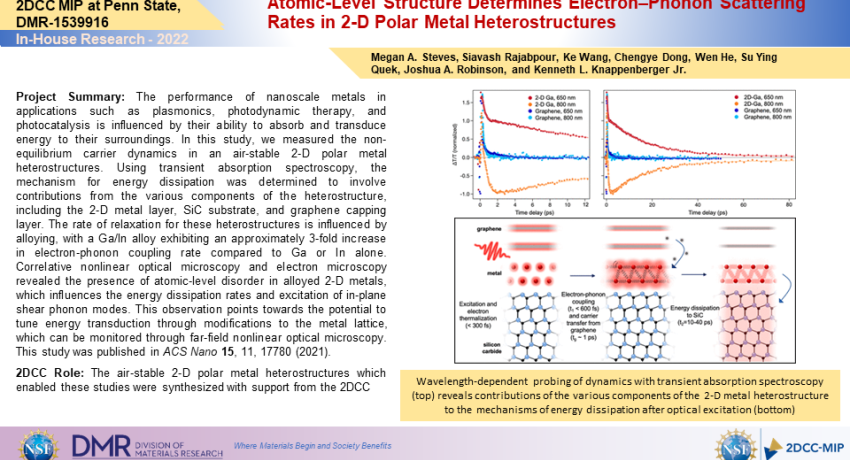Project Summary: The performance of nanoscale metals in applications such as plasmonics, photodynamic therapy, and photocatalysis is influenced by their ability to absorb and transduce energy to their surroundings. In this study, we measured the non-equilibrium carrier dynamics in an air-stable 2-D polar metal heterostructures. Using transient absorption spectroscopy, the mechanism for energy dissipation was determined to involve contributions from the various components of the heterostructure, including the 2-D metal layer, SiC substrate, and graphene capping layer. The rate of relaxation for these heterostructures is influenced by alloying, with a Ga/In alloy exhibiting an approximately 3-fold increase in electron-phonon coupling rate compared to Ga or In alone. Correlative nonlinear optical microscopy and electron microscopy revealed the presence of atomic-level disorder in alloyed 2-D metals, which influences the energy dissipation rates and excitation of in-plane shear phonon modes. This observation points towards the potential to tune energy transduction through modifications to the metal lattice, which can be monitored through far-field nonlinear optical microscopy. This study was published in ACS Nano 15, 11, 17780 (2021).
2DCC Role: The air-stable 2-D polar metal heterostructures which enabled these studies were synthesized with support from the 2DCC
What Has Been Achieved: The mechanism of energy dissipation in 2D metal heterostructures was determined using transient absorption spectroscopy, which involves contributions from the various components of the heterostructure on sub-picosecond, picosecond, and 10s of picosecond timescales. The rates of relaxation are dependent on the structure of the 2Dmetal, with Ga/In alloys exhibiting faster rates of electron-phonon scattering than In or Ga alone. Correlative nonlinear optical microscopy and electron microscopy revealed increased structural disorder in the Ga/In alloy, explaining the faster relaxation.
Importance of the Achievement: While the energy dissipation dynamics bulk coinage metals have been extensively studied, the effects of 2D confinement on metals has not been understood. This work reveals the impact that atomic-level structural disorder has on the dynamics of 2D metal heterostructures, and suggests avenues for controlling energy dissipation through alloying. Additionally, graphene-metal charge transfer was resolved in these systems, which could reduce thermal fouling in graphene-based technologies.
Unique Feature(s) of the MIP that Enabled this Achievement: The synthesis of 2D-polar metal heterostructures, which represent an attractive system for studying 2D metal dynamics due to their large lateral dimensions and air stability, was enabled by the 2DCC
(If Applicable) Publication:
Megan A. Steves, Siavash Rajabpour, Ke Wang, Chengye Dong, Wen He, Su Ying Quek, Joshua A. Robinson, and Kenneth L. Knappenberger Jr., ACS Nano 15, 11, 17780 (2021). DOI:10.1021/acsnano.1c05944
This work was supported by a grant from the Air Force Office of Scientific Research (FA-9550-18-1-0347 and FA9550-19-1-0295) and by the National Science Foundation Graduate Research Fellowship Program under grant no. DGE1255832. This work was also supported by the National Science Foundation under award number CHE-1807999, DMR-2011839, and cooperative agreement DMR-1539916. Funding was also provided by the Singapore National Research Foundation, Prime Minister’s Office, under its medium-sized center program. Calculations were performed on the NUS Graphene Research Centre cluster and National Supercomputing Centre Singapore (NSCC).
